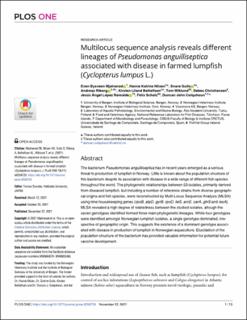Multilocus sequence analysis reveals different lineages of Pseudomonas anguilliseptica associated with disease in farmed lumpfish (Cyclopterus lumpus L.)
Mjølnerød, Even Bysveen; Nilsen, Hanne Katrine; Gulla, Snorre; Riborg, Andreas Ekroll; Bottolfsen, Kirsten; Wiklund, Tom; Christiansen, Debes; Romalde López, Jesús Ángel; Scholz, Felix; Colquhoun, Duncan John
Journal article, Peer reviewed
Published version

Åpne
Permanent lenke
https://hdl.handle.net/11250/2987230Utgivelsesdato
2021Metadata
Vis full innførselSamlinger
- Department of Biological Sciences [2232]
- Registrations from Cristin [9766]
Sammendrag
The bacterium Pseudomonas anguilliseptica has in recent years emerged as a serious threat to production of lumpfish in Norway. Little is known about the population structure of this bacterium despite its association with disease in a wide range of different fish species throughout the world. The phylogenetic relationships between 53 isolates, primarily derived from diseased lumpfish, but including a number of reference strains from diverse geographical origins and fish species, were reconstructed by Multi-Locus Sequence Analysis (MLSA) using nine housekeeping genes (rpoB, atpD, gyrB, rpoD, ileS, aroE, carA, glnS and recA). MLSA revealed a high degree of relatedness between the studied isolates, altough the seven genotypes identified formed three main phylogenetic lineages. While four genotypes were identified amongst Norwegian lumpfish isolates, a single genotype dominated, irrespective of geographic origin. This suggests the existence of a dominant genotype associated with disease in production of lumpfish in Norwegian aquaculture. Elucidation of the population structure of the bacterium has provided valuable information for potential future vaccine development.
